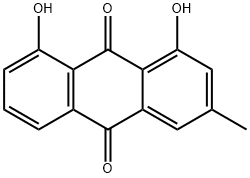Chrysophanic acid
Synonym(s):1,8-Dihydroxy-3-methylanthraquinone;3-Methylchrysazin;Chrysophanic acid
- CAS NO.:481-74-3
- Empirical Formula: C15H10O4
- Molecular Weight: 254.24
- MDL number: MFCD00001208
- EINECS: 207-572-2
- SAFETY DATA SHEET (SDS)
- Update Date: 2024-12-18 14:15:30

What is Chrysophanic acid?
Description
Chrysophanol is an anthraquinone that has been found in R. palmatum and has diverse biological activities. It induces necrosis in J5 human liver cancer cells when used at concentrations of 25, 50, 75, 100, and 200 μM. Chrysophanol (5, 10, and 50 μM) reduces LPS-induced production of nitric oxide (NO) and prostaglandin E2 (PGE2; ) and inhibits LPS-induced DNA oxidation in BV-2 microglia. In vivo, chrysophanol (5 mg/kg) decreases colonic levels of IL-6 and activation of NF-κB and reduces weight loss, diarrhea, and rectal bleeding in a mouse model of colitis induced by dextran sulfate (DSS; ). Chrysophanol (0.1, 1, and 10 mg/kg) increases survival, reduces brain tissue loss, and ameliorates motor balance deficits in a mouse model of ischemia-reperfusion injury induced by middle cerebral artery occlusion (MCAO).
Chemical properties
yellow crystalline solid or brown powder
The Uses of Chrysophanic acid
Chrysophanic acid, a natural anthraquinone, is used to study anticancer activity in EGFR-overexpressing SNU-C5 human colon cancer cells 1. It is also used to study the inhibition of replication of poliovirus types 2 and 3 (Picornaviridae) in vitro 2.
The Uses of Chrysophanic acid
antineoplastic, antibacterial
The Uses of Chrysophanic acid
A topical ointment used in the treatment of dermal conditions such as eczema and herpes.
What are the applications of Application
Chrysophanol is an inducer of intracellular Ca2+ concentration and exhibit antifungal activities
Definition
ChEBI: A trihydroxyanthraquinone that is chrysazin with a methyl substituent at C-3. It has been isolated from Aloe vera and exhibits antiviral and anti-inflammatory activity.
Synthesis Reference(s)
Tetrahedron Letters, 20, p. 4911, 1979 DOI: 10.1016/S0040-4039(01)86747-2
General Description
Golden yellow plates or brown powder. Melting point 196°C. Slightly soluble in water. Pale yellow aqueous solutions turn red on addition of alkali. Solutions in concentrated sulfuric acid are red.
Air & Water Reactions
Insoluble in water.
Reactivity Profile
Chrysophanic acid is incompatible with strong oxidizing agents.
Fire Hazard
Flash point data for Chrysophanic acid are not available; however, Chrysophanic acid is probably combustible.
Purification Methods
Crystallise chrysophanic acid from EtOH or *benzene and has m 195.6-196.2o, after sublimation it in a vacuum. The yellow mono-acetate has m 188-190o (from MeOH or Me2CO). It forms Ni2+, Co2+ and Cu2+ complexes. [Beilstein 8 H 470, 8 I 725, 8 II 510, 8 III 3808, 8 IV 3277.]
Properties of Chrysophanic acid
| Melting point: | 194-198 °C |
| Boiling point: | 357.45°C (rough estimate) |
| Density | 1.2693 (rough estimate) |
| refractive index | 1.4872 (estimate) |
| storage temp. | Inert atmosphere,Room Temperature |
| solubility | chloroform: soluble1% |
| form | crystalline |
| pka | 6.63±0.20(Predicted) |
| color | yellow-orange |
| Water Solubility | <0.1 g/100 mL at 18 ºC |
| λmax | 429nm(MeOH)(lit.) |
| Merck | 14,2258 |
| BRN | 1252300 |
| Stability: | Stable. Incompatible with strong oxidizing agents. |
| CAS DataBase Reference | 481-74-3(CAS DataBase Reference) |
| EPA Substance Registry System | Chrysophanic acid (481-74-3) |
Safety information for Chrysophanic acid
| Signal word | Warning |
| Pictogram(s) |
 Exclamation Mark Irritant GHS07 |
| GHS Hazard Statements |
H315:Skin corrosion/irritation H319:Serious eye damage/eye irritation H335:Specific target organ toxicity, single exposure;Respiratory tract irritation |
| Precautionary Statement Codes |
P261:Avoid breathing dust/fume/gas/mist/vapours/spray. P264:Wash hands thoroughly after handling. P264:Wash skin thouroughly after handling. P271:Use only outdoors or in a well-ventilated area. P280:Wear protective gloves/protective clothing/eye protection/face protection. P302+P352:IF ON SKIN: wash with plenty of soap and water. P305+P351+P338:IF IN EYES: Rinse cautiously with water for several minutes. Remove contact lenses, if present and easy to do. Continuerinsing. |
Computed Descriptors for Chrysophanic acid
New Products
(S)-3-Aminobutanenitrile hydrochloride 4-Methylphenylacetic acid N-Boc-D-alaninol N-BOC-D/L-ALANINOL Tert-butyl bis(2-chloroethyl)carbamate 3-Morpholino-1-(4-nitrophenyl)-5,6-dihydropyridin- 2(1H)-one Furan-2,5-Dicarboxylic Acid Tropic acid 1-Bromo-3,5-Di-Tert-Butylbenzene S-2-CHLORO PROPIONIC ACID ETHYL ISOCYANOACETATE 2-Bromo-1,3-Bis(Dimethylamino)Trimethinium Hexafluorophosphate 4-IODO BENZOIC ACID 3-NITRO-2-METHYL ANILINE 1-(2,4-DICHLOROPHENYL) ETHANAMINE (2-Hydroxyphenyl)acetonitrile 4-Bromopyrazole 2-(Cyanocyclohexyl)acetic acid 4-methoxy-3,5-dinitropyridine 1-(4-(aminomethyl)benzyl)urea hydrochloride 2-aminopropyl benzoate hydrochloride diethyl 2-(2-((tertbutoxycarbonyl)amino) ethyl)malonate tert-butyl 4- (ureidomethyl)benzylcarbamate Ethyl-2-chloro((4-methoxyphenyl)hydrazono)acetateRelated products of tetrahydrofuran








You may like
-
 Chrysophanic Acid CAS 481-74-3View Details
Chrysophanic Acid CAS 481-74-3View Details
481-74-3 -
 Chrysophanol 97% CAS 481-74-3View Details
Chrysophanol 97% CAS 481-74-3View Details
481-74-3 -
 Chrysophanol CAS 481-74-3View Details
Chrysophanol CAS 481-74-3View Details
481-74-3 -
 1975-50-4 98%View Details
1975-50-4 98%View Details
1975-50-4 -
 2-HYDROXY BENZYL ALCOHOL 98%View Details
2-HYDROXY BENZYL ALCOHOL 98%View Details
90-01-7 -
 2-Chloro-1,3-Bis(Dimethylamino)Trimethinium Hexafluorophosphate 221615-75-4 98%View Details
2-Chloro-1,3-Bis(Dimethylamino)Trimethinium Hexafluorophosphate 221615-75-4 98%View Details
221615-75-4 -
 14714-50-2 (2-Hydroxyphenyl)acetonitrile 98+View Details
14714-50-2 (2-Hydroxyphenyl)acetonitrile 98+View Details
14714-50-2 -
 118753-70-1 98+View Details
118753-70-1 98+View Details
118753-70-1